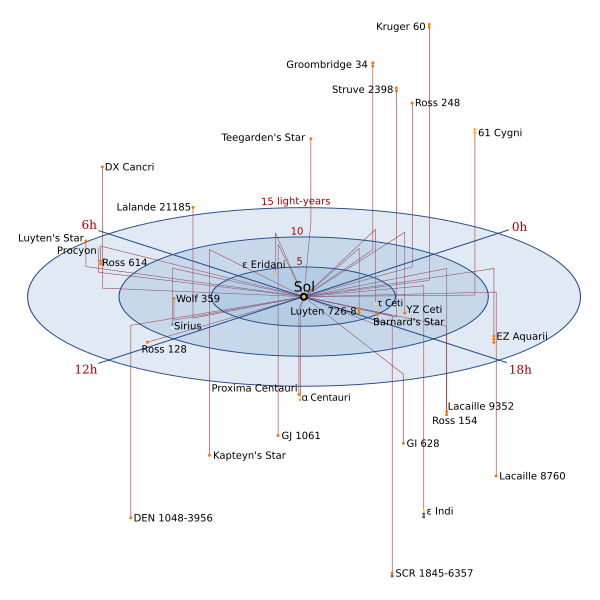Danh sách sao và sao lùn nâu gần nhất
Các sao gần Trái Đất nhất bên ngoài hệ Mặt Trời với khoảng cách chưa đến 5 pc đã được quan sát thấy bao gồm 50 hệ sao sau:
Danh sách
[sửa | sửa mã nguồn]

| # | Danh pháp | Phân loại sao | Cấp sao biểu kiến (mV) | Cấp sao tuyệt đối (MV) | Nhiệt độ hiệu lực Teff theo K (+/-) |
KNTV J2000.0 | Thị sai[1][2] Giây cung(±err) |
Khoảng cách[3] Năm ánh sáng (+/-) |
Tham khảo | |||
|---|---|---|---|---|---|---|---|---|---|---|---|---|
| Hệ thống sao | Sao | Sao # | Xích kinh[1] | Xích vĩ[1] | ||||||||
| Hệ Mặt Trời | Mặt Trời | G2V[1] | −26.74[1] | 4.85[1] | 5,778[4] | variable: the Sun travels along the ecliptic | 180° | 0,0000158(3) hay 8,32(16) phút ánh sáng |
có 8 hành tinh và 5 hành tinh lùn đã biết | |||
| 1 | Alpha Centauri (Rigil Kentaurus; Toliman) |
Proxima Centauri (V645 Centauri) | 1 | M5.5Ve | 11.09[1] | 15.53[1] | 3,040[5] | 14h 29m 43.0s | −62° 40′ 46″ | 0.768 87(0 29)″[6][7] | 4.2421(16) | [8] |
| α Centauri A (HD 128620) | 2 | G2V[1] | 0.01[1] | 4.38[1] | 5,790[5] | 14h 39m 36.5s | −60° 50′ 02″ | 0.747 23(1 17)″[6][9] | 4.3650(68) | |||
| α Centauri B (HD 128621) | 2 | K1V[1] | 1.34[1] | 5.71[1] | 5,260[5] | 14h 39m 35.1s | −60° 50′ 14″ | |||||
| 2 | Barnard's Star (BD+04°3561a) | 4 | M4.0Ve | 9.53[1] | 13.22[1] | 3,134(102)[10] | 17h 57m 48.5s | +04° 41′ 36″ | 0.546 98(1 00)″[6][7] | 5.9630(109) | ||
| 3 | Wolf 359 (CN Leonis) | 5 | M6.0V[1] | 13.44[1] | 16.55[1] | 2,800(100)[11] | 10h 56m 29.2s | +07° 00′ 53″ | 0.419 10(2 10)″[6] | 7.7825(390) | ||
| 4 | Lalande 21185 (BD+36°2147) | 6 | M2.0V[1] | 7.47[1] | 10.44[1] | 3,400[12] | 11h 03m 20.2s | +35° 58′ 12″ | 0.393 42(0 70)″[6][7] | 8.2905(148) | ||
| 5 | Sirius (α Canis Majoris) |
Sirius A | 7 | A1V[1] | −1.46[1] | 1.42[1] | 9,940(210)[13] | 06h 45m 08.9s | −16° 42′ 58″ | 0.380 02(1 28)″[6][7] | 8.5828(289) | |
| Sirius B | 7 | DA2[1] | 8.44[1] | 11.34[1] | 25.000(200)[14] | |||||||
| 6 | Luyten 726-8 | Luyten 726-8 A (BL Ceti) | 9 | M5.5Ve | 12.54[1] | 15.40[1] | 2,670 | 01h 39m 01.3s | −17° 57′ 01″ | 0.373 70(2 70)″[6] | 8.7280(631) | |
| Luyten 726-8 B (UV Ceti) | 10 | M6.0Ve | 12.99[1] | 15.85[1] | ~2,600 | |||||||
| 7 | Ross 154 (V1216 Sagittarii) | 11 | M3.5Ve | 10.43[1] | 13.07[1] | 2,700 | 18h 49m 49.4s | −23° 50′ 10″ | 0.336 90(1 78)″[6][7] | 9.6813(512) | ||
| 8 | Ross 248 (HH Andromedae) | 12 | M5.5Ve | 12.29[1] | 14.79[1] | ? | 23h 41m 54.7s | +44° 10′ 30″ | 0.316 00(1 10)″[6] | 10.322(36) | ||
| 9 | Epsilon Eridani (BD−09°697) | 13 | K2V[1] | 3.73[1] | 6.19[1] | 5,100 | 03h 32m 55.8s | −09° 27′ 30″ | 0.309 99(0 79)″[6][7] | 10.522(27) | có 1 hành tinh (second awaiting confirmation) | |
| 10 | Lacaille 9352 (CD−36°15693) | 14 | M1.5Ve | 7.34[1] | 9.75[1] | 3,340 | 23h 05m 52.0s | −35° 51′ 11″ | 0.303 64(0 87)″[6][7] | 10.742(31) | ||
| 11 | Ross 128 (FI Virginis) | 15 | M4.0Vn | 11.13[1] | 13.51[1] | 2,800 | 11h 47m 44.4s | +00° 48′ 16″ | 0.298 72(1 35)″[6][7] | 10.919(49) | 1 hành tinh Ross 128 b | |
| 12 | EZ Aquarii (GJ 866, Luyten 789-6) |
EZ Aquarii A | 16 | M5.0Ve | 13.33[1] | 15.64[1] | ? | 22h 38m 33.4s | −15° 18′ 07″ | 0.289 50(4 40)″[6] | 11.266(171) | |
| EZ Aquarii B | 16 | M? | 13.27[1] | 15.58[1] | ? | |||||||
| EZ Aquarii C | 16 | M? | 14.03[1] | 16.34[1] | ? | |||||||
| 13 | Procyon (α Canis Minoris) |
Procyon A | 19 | F5V-IV[1] | 0.38[1] | 2.66[1] | 6,650 | 07h 39m 18.1s | +05° 13′ 30″ | 0.286 05(0 81)″[6][7] | 11.402(32) | |
| Procyon B | 19 | DA[1] | 10.70[1] | 12.98[1] | 9,700 | |||||||
| 14 | 61 Cygni | 61 Cygni A (BD+38°4343) | 21 | K5.0V[1] | 5.21[1] | 7.49[1] | 4,640 | 21h 06m 53.9s | +38° 44′ 58″ | 0.286 04(0 56)″[6][7] | 11.403(22) | first star (other than Sun) to have its distance measured |
| 61 Cygni B (BD+38°4344) | 21 | K7.0V[1] | 6.03[1] | 8.31[1] | 4,440 | 21h 06m 55.3s | +38° 44′ 31″ | |||||
| 15 | Struve 2398 (GJ 725, BD+59°1915) |
Struve 2398 A (HD 173739) | 23 | M3.0V[1] | 8.90[1] | 11.16[1] | ? | 18h 42m 46.7s | +59° 37′ 49″ | 0.283 00(1 69)″[6][7] | 11.525(69) | |
| Struve 2398 B (HD 173740) | 23 | M3.5V[1] | 9.69[1] | 11.95[1] | ? | 18h 42m 46.9s | +59° 37′ 37″ | |||||
| 16 | Groombridge 34 (GJ 15) |
Groombridge 34 A (GX Andromedae) | 25 | M1.5V[1] | 8.08[1] | 10.32[1] | ? | 0h 18m 22.9s | +44° 01′ 23″ | 0.280 59(0 95)″[6][7] | 11.624(39) | |
| Groombridge 34 B (GQ Andromedae) | 25 | M3.5V[1] | 11.06[1] | 13.30[1] | ? | |||||||
| 17 | Epsilon Indi (CPD−57°10015) |
Epsilon Indi A | 27 | K5Ve[1] | 4.69[1] | 6.89[1] | 4,280 | 22h 03m 21.7s | −56° 47′ 10″ | 0.275 84(0 69)″[6][7] | 11.824(30) | |
| Epsilon Indi Ba | 27 | T1.0V | >23 | >25 | 1,280 | 22h 04m 10.5s | −56° 46′ 58″ | |||||
| Epsilon Indi Bb | 27 | T6.0V | >23 | >25 | 850 | |||||||
| 18 | DX Cancri (G 51-15) | 30 | M6.5Ve | 14.78[1] | 16.98[1] | ? | 08h 29m 49.5s | +26° 46′ 37″ | 0.275 80(3 00)″[6] | 11.826(129) | ||
| 19 | Tau Ceti (BD−16°295) | 31 | G8Vp[1] | 3.49[1] | 5.68[1] | 5,344 | 01h 44m 04.1s | −15° 56′ 15″ | 0.274 39(0 76)″[6][7] | 11.887(33) | ||
| 20 | GJ 1061 (LHS 1565) | 32 | M5.5V[1] | 13.09[1] | 15.26[1] | ? | 03h 35m 59.7s | −44° 30′ 45″ | 0.272 01(1 30)″[15] | 11.991(57) | [16][17] | |
| 21 | YZ Ceti (LHS 138) | 33 | M4.5V[1] | 12.02[1] | 14.17[1] | ? | 01h 12m 30.6s | −16° 59′ 56″ | 0.268 84(2 95)″[6][7] | 12.132(133) | ||
| 22 | Luyten's Star (BD+05°1668) | 34 | M3.5Vn | 9.86[1] | 11.97[1] | ? | 07h 27m 24.5s | +05° 13′ 33″ | 0.263 76(1 25)″[6][7] | 12.366(59) | ||
| 23 | Teegarden's star (SO025300.5+165258) | 35 | M6.5V | 15.14[1] | 17.22[1] | ? | 02h 53m 00.9s | +16° 52′ 53″ | 0.260 63(2 69)″[15] | 12.514(129) | [17] | |
| 24 | SCR 1845-6357 | SCR 1845-6357 A | 36 | M8.5V[1] | 17.39 | 19.41 | ? | 18h 45m 05.3s | −63° 57′ 48″ | 0.259 45(1 11)″[15] | 12.571(54) | [17] |
| SCR 1845-6357 B | 36 | T6[18] | ? | ? | 950[18] | 18h 45m 02.6s | −63° 57′ 52″ | |||||
| 25 | Kapteyn's Star (CD−45°1841) | 38 | M1.5V[1] | 8.84[1] | 10.87[1] | 3,800 | 05h 11m 40.6s | −45° 01′ 06″ | 0.255 27(0 86)″[6][7] | 12.777(43) | ||
| 26 | Lacaille 8760 (AX Microscopii) | 39 | M0.0V[1] | 6.67[1] | 8.69[1] | 3,340 | 21h 17m 15.3s | −38° 52′ 03″ | 0.253 43(1 12)″[6][7] | 12.870(57) | ||
| 27 | Kruger 60 (BD+56°2783) |
Kruger 60 A | 40 | M3.0V[1] | 9.79[1] | 11.76[1] | 3,180 | 22h 27m 59.5s | +57° 41′ 45″ | 0.248 06(1 39)″[6][9] | 13.149(74) | |
| Kruger 60 B (DO Cephei) | 40 | M4.0V[1] | 11.41[1] | 13.38[1] | 2,890 | |||||||
| 28 | DEN 1048-3956 | 42 | M8.5V[1] | 17.39[1] | 19.37[1] | ? | 10h 48m 14.7s | −39° 56′ 06″ | 0.247 71(1 55)″[15] | 13.167(82) | [19][20] | |
| 29 | Ross 614 (V577 Monocerotis, GJ 234) |
Ross 614A (LHS 1849) | 43 | M4.5V[1] | 11.15[1] | 13.09[1] | ? | 06h 29m 23.4s | −02° 48′ 50″ | 0.244 34(2 01)″[6][9] | 13.349(110) | |
| Ross 614B (LHS 1850) | 43 | M5.5V | 14.23[1] | 16.17[1] | ? | |||||||
| 30 | Wolf 1061 (GJ 628, BD−12°4523) | 45 | M3.0V[1] | 10.07[1] | 11.93[1] | ? | 16h 30m 18.1s | −12° 39′ 45″ | 0.236 01(1 67)″[6][7] | 13.820(98) | ||
| 31 | Van Maanen's star (GJ 35, LHS 7) | 46 | DZ7[1] | 12.38[1] | 14.21[1] | ? | 00h 49m 09.9s | +05° 23′ 19″ | 0.231 88(1 79)″[6][7] | 14.066(109) | ||
| 32 | Gliese 1 (CD−37°15492) | 47 | M3.0V[1] | 8.55[1] | 10.35[1] | ? | 00h 05m 24.4s | −37° 21′ 27″ | 0.229 20(1 07)″[6][7] | 14.231(66) | ||
| 33 | Wolf 424 (FL Virginis, LHS 333, GJ 473) |
Wolf 424 A | 48 | M5.5Ve | 13.18[1] | 14.97[1] | ? | 12h 33m 17.2s | +09° 01′ 15″ | 0.227 90(4 60)″ [6] | 14.312(289) | |
| Wolf 424 B | 48 | M7Ve | 13.17[1] | 14.96[1] | ? | |||||||
| 34 | TZ Arietis (GJ 83.1, Luyten 1159-16) | 50 | M4.5V[1] | 12.27[1] | 14.03[1] | ? | 02h 00m 13.2s | +13° 03′ 08″ | 0.224 80(2 90)″[6] | 14.509(187) | ||
| 35 | GJ 687 (LHS 450, BD+68°946) | 51 | M3.0V[1] | 9.17[1] | 10.89[1] | ? | 17h 36m 25.9s | +68° 20′ 21″ | 0.220 49(0 82)″[6][7] | 14.793(55) | ||
| 36 | LHS 292 (LP 731-58) | 52 | M6.5V[1] | 15.60[1] | 17.32[1] | ? | 10h 48m 12.6s | −11° 20′ 14″ | 0.220 30(3 60)″[6] | 14.805(242) | ||
| 37 | GJ 674 (LHS 449) | 53 | M3.0V[1] | 9.38[1] | 11.09[1] | ? | 17h 28m 39.9s | −46° 53′ 43″ | 0.220 25(1 59)″[6][7] | 14.809(107) | có 1 hành tinh | |
| 38 | GJ 1245 | GJ 1245 A | 54 | M5.5V[1] | 13.46[1] | 15.17[1] | ? | 19h 53m 54.2s | +44° 24′ 55″ | 0.220 20(1 00)″[6] | 14.812(67) | |
| GJ 1245 B | 54 | M6.0V[1] | 14.01[1] | 15.72[1] | ? | 19h 53m 55.2s | +44° 24′ 56″ | |||||
| GJ 1245 C | 54 | M? | 16.75[1] | 18.46[1] | ? | 19h 53m 54.2s | +44° 24′ 55″ | |||||
| 39 | GJ 440 (WD 1142-645) | 57 | DQ6[1] | 11.50[1] | 13.18[1] | 7,500 | 11h 45m 42.9s | −64° 50′ 29″ | 0.216 57(2 01)″[6][7] | 15.060(140) | ||
| 40 | GJ 1002 | 58 | M5.5V[1] | 13.76[1] | 15.40[1] | ? | 00h 06m 43.8s | −07° 32′ 22″ | 0.213 00(3 60)″[6] | 15.313(259) | ||
| 41 | Gliese 876 (Ross 780) | 59 | M3.5V[1] | 10.17[1] | 11.81[1] | 3,480 | 22h 53m 16.7s | −14° 15′ 49″ | 0.212 59(1 96)″[6][7] | 15.342(141) | có 3 hành tinh | |
| 42 | LHS 288 (Luyten 143-23) | 60 | M5.5V[1] | 13.90[1] | 15.51[1] | ? | 10h 44m 21.2s | −61° 12′ 36″ | 0.208 95(2 73)″[15] | 15.610(204) | [17] | |
| 43 | GJ 412 | GJ 412 A | 61 | M1.0V[1] | 8.77[1] | 10.34[1] | ? | 11h 05m 28.6s | +43° 31′ 36″ | 0.206 02(1 08)″[6][7] | 15.832(83) | |
| GJ 412 B (WX Ursae Majoris) | 61 | M5.5V[1] | 14.48[1] | 16.05[1] | ? | 11h 05m 30.4s | +43° 31′ 18″ | |||||
| 44 | Groombridge 1618 (GJ 380) | 63 | K7.0V[1] | 6.59[1] | 8.16[1] | 4,000 | 10h 11m 22.1s | +49° 27′ 15″ | 0.205 81(0 67)″[6][7] | 15.848(52) | ||
| 45 | GJ 388 | 64 | M3.0V[1] | 9.32[1] | 10.87[1] | ? | 10h 19m 36.4s | +19° 52′ 10″ | 0.204 60(2 80)″[6] | 15.942(218) | ||
| 46 | Gliese 832 | 65 | M3.0V[1] | 8.66[1] | 10.20[1] | ? | 21h 33m 34.0s | −49° 00′ 32″ | 0.202 78(1 32)″[6][7] | 16.085(105) | có 1 hành tinh | |
| 47 | LP 944-020 | 66 | M9.0V[1] | 18.50[1] | 20.02[1] | ? | 03h 39m 35.2s | −35° 25′ 41″ | 0.201 40(4 20)″[21] | 16.195(338) | ||
| 48 | DEN 0255-4700 | 67 | L7.5V[1] | 22.92[1] | 24.44[1] | ? | 02h 55m 03.7s | −47° 00′ 52″ | 0.201 37(3 89)″[15] | 16.197(313) | [20] | |
| Parallax margin of error overlaps 0.200″ | ||||||||||||
| 49 | GJ 682 | 68 | M4.5V[1] | 10.95[1] | 12.45[1] | ? | 17h 37m 03.7s | −44° 19′ 09″ | 0.199 65(2 30)″[6][7] | 16.337(188) | ||
| # | Hệ thống sao | Sao | Sao # | Phân loại sao | Cấp sao biểu kiến (mV) | Cấp sao tuyệt đối (MV) | Nhiệt độ hiệu lực Teff theo K (±err) |
Xích kinh[1] | Xích vĩ[1] | Thị sai[1][2] Giây cung(±err) |
Khoảng cách[3] Light-years (±err) |
Additional references |
| Danh pháp | KNTV J2000.0 | |||||||||||
Bản đồ sao
[sửa | sửa mã nguồn]
Tham khảo
[sửa | sửa mã nguồn]- ^ a b c d e f g h i j k l m n o p q r s t u v w x y z aa ab ac ad ae af ag ah ai aj ak al am an ao ap aq ar as at au av aw ax ay az ba bb bc bd be bf bg bh bi bj bk bl bm bn bo bp bq br bs bt bu bv bw bx by bz ca cb cc cd ce cf cg ch ci cj ck cl cm cn co cp cq cr cs ct cu cv cw cx cy cz da db dc dd de df dg dh di dj dk dl dm dn do dp dq dr ds dt du dv dw dx dy dz ea eb ec ed ee ef eg eh ei ej ek el em en eo ep eq er es et eu ev ew ex ey ez fa fb fc fd fe ff fg fh fi fj fk fl fm fn fo fp fq fr fs ft fu fv fw fx fy fz ga gb Research Consortium on Nearby Stars, GSU (2007-September 17). “The One Hundred Nearest Star Systems”. RECONS. Truy cập ngày 6 tháng 11 năm 2007. Kiểm tra giá trị ngày tháng trong:
|date=(trợ giúp); Liên kết ngoài trong|journal=(trợ giúp) - ^ a b Parallaxes given by RECONS are a weighted mean of values in the sources given, as well as measurements by the RECONS program.
- ^ a b From parallax.
- ^ Sun Fact Sheet, NASA. Truy cập 8 tháng 11 năm 2007.
- ^ a b c Kervella, Pierre; Thevenin, Frederic (ngày 15 tháng 3 năm 2003). “A Family Portrait of the Alpha Centauri System: VLT Interferometer Studies the Nearest Stars”. ESO Press Release 05/03. ESO. Bản gốc lưu trữ ngày 16 tháng 6 năm 2008. Truy cập ngày 8 tháng 11 năm 2007.Quản lý CS1: nhiều tên: danh sách tác giả (liên kết)
- ^ a b c d e f g h i j k l m n o p q r s t u v w x y z aa ab ac ad ae af ag ah ai aj ak al am an ao ap aq General Catalogue of Trigonometric Parallaxes.
- ^ a b c d e f g h i j k l m n o p q r s t u v w x y z aa ab ac Hipparcos Catalogue.
- ^ Burgasser et al. 2000
- ^ a b c Visual binary orbits and masses post Hipparcos, Staffan Söderhjelm, Astronomy and Astrophysics 341 (tháng 1 năm 1999), các trang 121–140.
- ^ Barnard's Star and the M Dwarf Temperature Scale, P. C. Dawson and M. M. de Robertis, The Astronomical Journal 127, #5 (tháng 5 năm 2004), các trang 2909–2914. doi:10.1086/383289
- ^ Ya. V. Pavlenko, H. R. A. Jones, Yu. Lyubchik, J. Tennyson, and D. J. Pinfield (2006). “Spectral energy distribution for GJ406”. Astronomy and Astrophysics. 447 (2): 709–717. doi:10.1051/0004-6361:20052979.Quản lý CS1: nhiều tên: danh sách tác giả (liên kết)
- ^ Carbon monoxide bands in M dwarfs, Y. V. Pavlenko and H. R. A. Jones, Astronomy and Astrophysics 396 (tháng 12 năm 2002), các trang 967–975. doi:10.1051/0004-6361:20021454
- ^ Table 2, The physical properties of normal A stars, Saul J. Adelman, các trang 1–11, The A-Star Puzzle, Proceedings of the International Astronomical Union, edited by J. Zverko, J. Ziznovsky, S. J. Adelman, and W. W. Weiss, Cambridge, UK: Cambridge University Press, 2004. doi:10.1017/S1743921304004314
- ^ Adopted value, The Age and Progenitor Mass of Sirius B, James Liebert, Patrick A. Young, David Arnett, J.B. Holberg, and Kurtis A. Williams, The Astrophysical Journal 630, #1 (tháng 9 năm 2005), các trang L69–L72.
- ^ a b c d e f Systems with their first accurate trigonometric parallaxes measured by RECONS
- ^ The solar neighborhood IV: discovery of the twentieth nearest star, Todd J. Henry, Philip A. Ianna, J. Davy Kirkpatrick, Hartmut Jahreiss, The Astronomical Journal 114, #1 (tháng 7 năm 1997), các trang 388–395. doi:10.1086/118482
- ^ a b c d The Solar Neighborhood. XVII. Parallax Results from the CTIOPI 0.9 m Program: 20 New Members of the RECONS 10 Parsec Sample, Todd J. Henry, Wei-Chun Jao, John P. Subasavage, Thomas D. Beaulieu, Philip A. Ianna, Edgardo Costa, René A. Méndez, The Astronomical Journal 132, #6 (tháng 12 năm 2006), các trang 2360–2371. doi:10.1086/508233
- ^ a b The very nearby M/T dwarf binary SCR 1845-6357, Markus Kasper, Beth A. Biller, Adam Burrows, Wolfgang Brandner, Jano Budaj, and Laird M. Close, Astronomy and Astrophysics 471, #2 (tháng 8 năm 2007), các trang 655–659. doi:10.1051/0004-6361:20077881
- ^ The Solar Neighborhood. XIII. Parallax Results from the CTIOPI 0.9 Meter Program: Stars with μ >= 1.0" yr-1 (Motion sample), Wei-Chun Jao, Todd J. Henry, John P. Subasavage, Misty A. Brown, Philip A. Ianna, Jennifer L. Bartlett, Edgardo Costa, René A. Méndez, The Astronomical Journal 129, #4 (tháng 4 năm 2005), các trang 1954–1967. doi:10.1086/428489
- ^ a b The Solar Neighborhood. XIV. Parallaxes from the Cerro Tololo Inter-American Observatory Parallax Investigation—First Results from the 1.5 m Telescope Program, Edgardo Costa, René A. Méndez, W.-C. Jao, Todd J. Henry, John P. Subasavage, Misty A. Brown, Philip A. Ianna, and Jennifer Bartlett, The Astronomical Journal 130, #1 (tháng 7 năm 2005), các trang 337–349. doi:10.1086/430473
- ^ CCD astrometry of southern very low-mass stars, C. G. Tinney, Monthly Notices of the Royal Astronomical Society 281, #2 (tháng 7 năm 1996), các trang 644–658.
Liên kết ngoài
[sửa | sửa mã nguồn]- “NStars database”. NAU. Bản gốc lưu trữ ngày 30 tháng 10 năm 2005. Truy cập ngày 24 tháng 10 năm 2005.
- “100 nearest star systems”. RECONS. Truy cập ngày 19 tháng 11 năm 2008.
- “Map of the 25 nearest star systems”. NASA. Truy cập ngày 24 tháng 10 năm 2005.
- “Notable Nearby Stars”. SolStation. Truy cập ngày 24 tháng 10 năm 2005.
- “Cool stars in the solar Neighbourhood”. D. Montes, UCM. Truy cập ngày 14 tháng 11 năm 2005.
- The dynamics of the closest stars
- Takeda, G. (2006). “Structure and Evolution of Nearby Stars with Planets II. Physical Properties of ~ 1000 Cool Stars from the SPOCS Catalog”. E. B. Ford, A. Sills, F. A. Rasio, D. A. Fischer, J. A. Valenti. California & Carnegie Planet Search. Truy cập ngày 13 tháng 10 năm 2006.
Chúng tôi bán
![[Review Sách] 7 Định luật giảng dạy](https://down-bs-vn.img.susercontent.com/vn-11134207-7qukw-lidxs3ynamto6c.webp) GIẢM
12%
GIẢM
12%
218.000 ₫
248.000 ₫
 GIẢM
50%
GIẢM
50%
19.000 ₫
38.000 ₫
 GIẢM
13%
GIẢM
13%
400.000 ₫
460.000 ₫
 GIẢM
23%
GIẢM
23%
134.750 ₫
175.000 ₫
 GIẢM
38%
GIẢM
38%
75.000 ₫
120.000 ₫




![[Lôi Thần] Không về phe Thiên Lý và mục đích của](https://gamek.mediacdn.vn/133514250583805952/2021/7/9/c2e58-16229262575586-800-16258434373711138241017.jpg)
